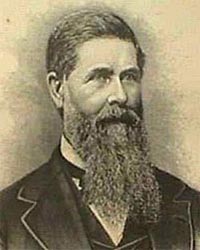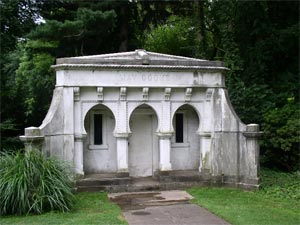Jay Cooke Biography
 Birth: August 10, 1821
Birth: August 10, 1821
Died: February 18, 1905
Union Civil War Financier, Jay Cooke was born in Sandusky, Ohio. The family estate was named Ogontz in honor of an Indian chief who once lived on the same land. The limestone dwelling overlooked Sandusky Bay and Lake Erie. Jay’s father, Eleutheros Cooke, a lawyer, and mother Martha Caswell, were educated easterners and very active politically. The braved a difficult journey from the east before settling in the untamed region around Sandusky in 1827. Eleutheros went on to serve in Congress as a Whig. The area was a paradise of teeming deer, waterfowl and fish. While growing up there, Jay developed his lifelong passion for Hunting and fishing. His early education was mainly from home schooling. At age 14, he began work at a Sandusky dry goods store where he became the head clerk while the owner taught him business and financial procedures. Then barely sixteen, a job led him to St. Louis and employment with Seymour & Bool where he earned an unheard sum of $600 a year. He was on his way at age 18, landing a clerk position with the banking firm E.W. Clark & Company which five years later led to a full partnership. Upon retirement, Cooke founded his own banking House known as Jay Cooke & Company of Philadelphia. His bankl was chosen By Secretary of the Treasury Salmon P. Chase (former Ohio senator and governor) to issue United States bonds to finance the Civil War. He raised over a billion dollars with the sale of various types of treasury bonds which allowed the Union to finance the war providing horses, guns and supplies while paying the men until victory over the South was achieved and the Union restored. In the postwar, Cooke became interested in the development of the Northwest and his bank financed the construction of the Northern Pacific Railway which was his undoing. In advancing money for the project, funds were lacking and during the Panic of 1873, the project was suspended with Cooke himself forced into bankruptcy. However, some six years later, he was again solvent and managed to meet all the financial obligations incurred during his insolvency. He was a Philanthropist on a grand scale, with the Episcopal Church receiving the Bulk with donated funds for the construction of a number of churches. One is located at Put-in-Bay, Ohio.
Jay Cooke leaves as his legacy the fact that he was the creator of municipal bonds, the practice where bankers stabilize the price of new bond issues that is still used today by investment institutions
His residency and construction of a palatial home in Cheltenham Township, Pennsylvania which he dubbed Ogontz after his boyhood home in Sandusky influence the naming of many area Philadelphia landmarks. Two decades later, the estate and dwelling became the exclusive Ogontz School for girls and the surrounding area became the city of Ogontz, Pennsylvania. Ogontz Avenue is a main avenue transecting the city of Philadelphia. The Jay Cooke Elementary School in the Logan section of the city bares his name and further away near Duluth, Minnesota lies the jewel of state parks: The Jay Cooke State Park, originated from land donated by the Northern Pacific Railroad which Cooke owned. The Cooke Castle in Ohio is a multi-room limestone dwelling on Gibraltar Island located in the harbor of South Bass Island on Lake Erie which he purchased. It was here that he and his family spent every summer until his death in 1905.
 The island has the highest island in the Put-in-Bay area and which was used as a lookout point for Commander Oliver Perry in the was against the British during the War of 1812 when he and his Men defeated a fleet of British vessels during the famous Battle of Lake Erie. Today, Gibraltar Island and the Castle belong to Ohio State University and is a lake laboratory for the teaching, learning and research. The Castle is a Federal Historic Site and is currently being refurbished.
The island has the highest island in the Put-in-Bay area and which was used as a lookout point for Commander Oliver Perry in the was against the British during the War of 1812 when he and his Men defeated a fleet of British vessels during the famous Battle of Lake Erie. Today, Gibraltar Island and the Castle belong to Ohio State University and is a lake laboratory for the teaching, learning and research. The Castle is a Federal Historic Site and is currently being refurbished.
Jay Cooke is buried in Saint Paul’s Episcopal Churchyard in Elkins Park, Montgomery County, Pennsylvania.
Ref.: Find A Grave: Jay Cooke (edited)
Picture credits: (1) Donald Greyfield; (2) Thomas Fisher